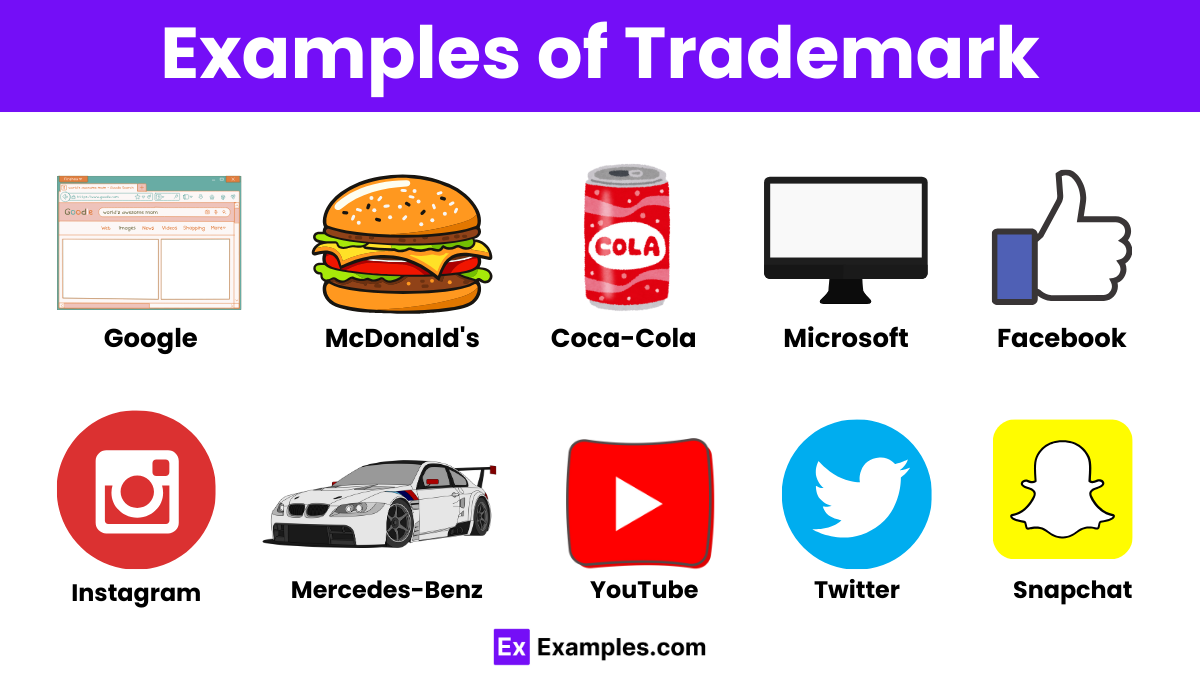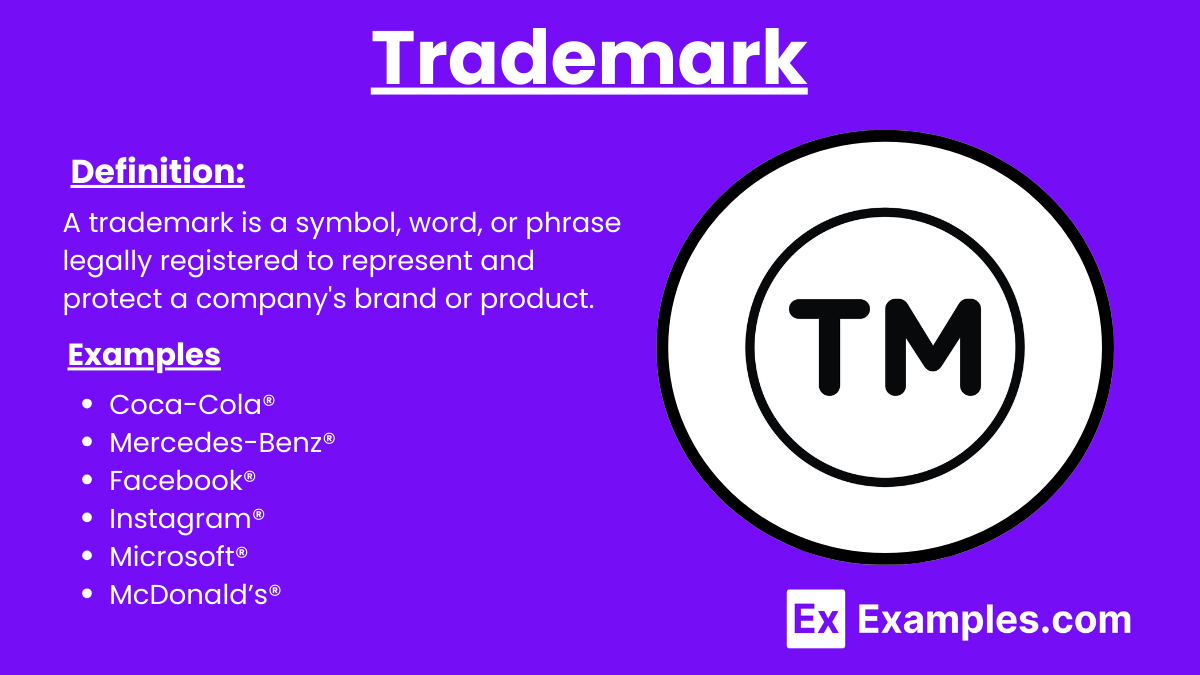30+ Trademark Examples to Download
A trademark is a unique symbol, word, or phrase that identifies and distinguishes a company’s products or services. It acts as a company banner, providing legal protection and ensuring brand recognition. Trademarks prevent competitors from using similar identifiers that could confuse consumers. They can include logos, slogans, and even specific colors or sounds. Registering a trademark strengthens a brand’s identity and builds trust with customers, making it an essential asset for any business.
What is a Trademark?
A trademark is a legally recognized symbol, word, or phrase that identifies and distinguishes a company’s products or services. It serves as a brand’s identifier, offering legal protection against unauthorized use and helping consumers recognize and trust the brand.
Examples of Trademark

- Coca-Cola®
- Nike®
- Apple®
- McDonald’s®
- Google®
- Microsoft®
- Starbucks®
- Amazon®
- Disney®
- Facebook®
- Pepsi®
- Adidas®
- Intel®
- Samsung®
- IBM®
- Toyota®
- Netflix®
- Visa®
- BMW®
- Mercedes-Benz®
- Instagram®
- YouTube®
- Twitter®
- LinkedIn®
- Pinterest®
- Snapchat®
Famous Trademark Examples
- Coca-Cola® : Coca-Cola’s trademark includes its distinctive script logo and the iconic contour bottle design. This trademark ensures the brand’s unique identity and prevents imitation by competitors.
- Nike® : Nike’s “swoosh” logo and the phrase “Just Do It” are globally recognized trademarks. They symbolize quality athletic apparel and footwear, helping the brand maintain its market dominance.
- Apple® : Apple’s trademark includes the bitten apple logo, representing innovation and sleek design in technology. This trademark reinforces brand loyalty and distinguishes Apple products from competitors.
- McDonald’s® : The golden arches and the phrase “I’m Lovin’ It” are key trademarks for McDonald’s. These symbols are synonymous with fast food and consistency, making McDonald’s a household name worldwide.
- Google® : Google’s trademark encompasses its colorful logo and the name itself. These trademarks have become synonymous with online search and digital innovation, securing Google’s position as a tech giant.
- Microsoft® : Microsoft’s trademark includes its four-color square logo and the name “Microsoft.” These trademarks represent reliability and innovation in software and technology.
- Starbucks® : Starbucks’ green siren logo is a well-known trademark in the coffee industry. It signifies quality coffee and a unique café experience, attracting loyal customers globally.
- Amazon® : Amazon’s trademark includes its curved arrow logo and the name “Amazon.” These trademarks symbolize a vast selection of products and exceptional customer service in e-commerce.
- Disney® : Disney’s trademark features the distinctive signature logo and the castle image. These trademarks evoke a sense of magic and entertainment, making Disney a beloved brand for all ages.
- Facebook® : Facebook’s trademark includes the blue “f” logo and the name “Facebook.” These trademarks are synonymous with social networking and digital connectivity.
Different types of trademarks
- Word Marks : Protect brand names or slogans used to identify goods or services.
- Design Marks : Protect logos or designs that represent a brand visually.
- Service Marks : Identify and distinguish services rather than physical products.
- Trade Dress : Protects the visual appearance or packaging of a product.
- Collective Marks : Used by members of an association to indicate membership.
- Certification Marks : Certify the quality or origin of goods or services.
- Sound Marks : Protect distinctive sounds associated with a brand.
- Color Marks : Protect specific colors used in branding or packaging.
- Motion Marks : Protect moving images or sequences representing a brand.
- Scent Marks : Protect distinctive smells used to identify a brand.
Trademarks Registration
Step 1: Conduct a Trademark Search
Ensure your trademark isn’t already in use by others.
Step 2: Prepare Your Application
Gather necessary information and documentation for submission.
Step 3: File with the USPTO
Submit your application to the United States Patent and Trademark Office.
Step 4: Application Review
The USPTO examines your application for compliance and potential conflicts.
Step 5: Publication for Opposition
Your trademark is published in the Official Gazette for public objection.
Step 6: Registration Certificate
If no oppositions, receive your official trademark registration certificate.
Step 7: Maintain Your Trademark
File periodic maintenance documents to keep your trademark active.
How to Trademark a Name
Step 1: Conduct a Name Search
Check the USPTO database to ensure the name isn’t already trademarked.
Step 2: Determine the Trademark Type
Decide if your name will be a standard character mark or a special form mark.
Step 3: Prepare the Application
Gather information such as the name, its use, and the associated goods/services.
Step 4: File with the USPTO
Submit your application online through the USPTO’s Trademark Electronic Application System (TEAS).
Step 5: Pay the Filing Fee
The fee varies based on the application type and number of classes of goods/services.
Step 6: Monitor Your Application
The USPTO reviews your application, a process that may take several months.
Step 7: Respond to Office Actions
If the USPTO raises any issues, respond promptly to any office actions.
Step 8: Publication for Opposition
Your name is published in the Official Gazette for a 30-day opposition period.
Step 9: Receive Approval
If there are no oppositions, the USPTO will approve and register your trademark.
Step 10: Maintain Your Trademark
File maintenance documents as required to keep your trademark active.
What are the three most common trademarks?
- Word Marks : These trademarks protect brand names, slogans, or taglines made up of words or letters. They are the most straightforward and widely used type of trademark, and are essential in a networking strategy plan to ensure clear and consistent brand communication.
- Design Marks : These trademarks protect logos, symbols, or designs that visually represent a brand. They help distinguish a company’s goods or services through visual imagery, such as those found on a graphic designer’s business card.
- Composite Marks : These trademarks combine both word marks and design marks in a single trademark. They protect the combined visual and textual elements that represent a brand, such as a fashion logo that incorporates both the brand name and distinctive design elements.
Owning a trademark vs. having a registered trademark
Owning a Trademark:
Owning a trademark provides some level of protection under common law, based on the use of the mark in commerce. This ownership can be established without formal registration, giving you the right to use the trademark and potentially enforce it within your geographical area. For example, if a band starts using a unique name, they own that trademark as long as they continue to use it in their performances and marketing. This ownership can be referenced in a band contract or an intellectual property agreement to outline rights and usage. However, this level of protection is limited and may not be sufficient for broader enforcement or protection in other regions.
Registered Trademark:
Having a registered trademark provides a much higher level of protection and several legal benefits. Registration is done through the relevant government agency, such as the USPTO in the United States. A registered trademark gives the owner exclusive rights to use the mark nationwide (or even internationally, depending on the registration) and makes it easier to enforce these rights against infringers. For instance, a band with a registered trademark can more effectively prevent other bands from using the same or similar name, ensuring their brand identity, including their music logo, is protected across all platforms and locations. This legal protection can be crucial in a band contract and licensing agreement examples, ensuring that the band’s name and associated brand elements are safeguarded.
What Can be Trademarked?
Brand Names
Unique names that distinguish products or services from competitors.
Logos
Distinctive designs or symbols representing a brand.
Slogans
Catchy phrases associated with a brand’s products or services.
Product Names
Specific names of products within a brand.
Service Names
Names of particular services offered by a company.
Sounds
Unique a identifiers, like jingles or specific sounds associated with a brand.
Colors
Specific color schemes used distinctively in branding.
Shapes
Distinctive shapes of products or packaging.
Symbols
Unique marks or icons representing a brand.
Designs
Original patterns or designs used in branding.
What Can’t Be Trademarked?
Generic Terms
Common names for products or services (e.g., “Computer” for a computer brand).
Descriptive Terms
Terms that merely describe a product or service without distinctiveness (e.g., “Fresh” for produce).
Deceptive Marks
Marks that could mislead consumers about the nature or quality of a product.
Surnames
Common last names unless they have acquired distinctiveness through use.
Functional Features
Elements of a product that are essential to its use or affect its cost or quality (e.g., a unique grip on a tool).
Scandalous or Offensive Material
Marks that contain obscene or immoral content.
Geographic Names
Names that are primarily geographic unless they have gained distinctiveness (e.g., “California Wine”).
Government Symbols
Official symbols or insignia of government entities (e.g., national flags, official seals).
Why should I register a trademark?
Registering a trademark provides legal protection against unauthorized use and helps build brand identity.
How do I register a trademark?
You can register a trademark through the United States Patent and Trademark Office (USPTO) or similar international agencies.
What can be trademarked?
Names, logos, slogans, and even sounds or colors associated with a brand can be trademarked.
How long does trademark registration take?
The process typically takes 6 to 12 months, depending on the complexity and any legal issues.
How long does a trademark last?
In the U.S., trademarks last for 10 years and can be renewed indefinitely.
What is a licensing agreement?
A licensing agreement allows others to use your trademark under specific conditions, often for a fee.
What is an intellectual property agreement?
An intellectual property agreement protects various forms of intellectual property, including trademarks, patents, and copyrights.
Can I trademark a common word?
Common words can be trademarked if they acquire a distinctive secondary meaning associated with your brand.
What is the difference between ™ and ®?
™ indicates an unregistered trademark, while ® signifies a registered trademark.
Can I use my trademark internationally?
To use a trademark internationally, you must register it in each country or through international agreements like the Madrid Protocol.


